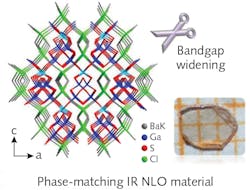Bandgap widening in IR nonlinear optical material achieves phase-matching, high efficiency

Nonlinear optical (NLO) crystals are widely used for their frequency-conversion capabilities. Numerous infrared nonlinear optical (NLO) materials with high NLO coefficients have been studied, but many of them suffer from a lack of phase matching (PM), which dramatically decreases their ultimate NLO output efficiencies. A research group led by Guo Guocong from Fujian Institute of Research on the Structure of Matter (FJIRSM) of the Chinese Academy of Sciences (Beijing, China) has developed a new strategy involving modulating the NLO material’s normal dispersion via bandgap-widening to achieve PM.
Three new wide-optical-bandgap (on the order of 4.0 eV) IR NLO salt-inclusion sulfides with the general formula [ABa3Cl2][Ga5S10] with A = potassium (K), rubidium (Rb), or cesium (Cs) with PM behaviors were successfully synthesized. Typically, the wider the optical bandgap, the flatter the normal dispersion curves in the mid- and far-IR regions. Compared with isomorphism selenides (such as antimony selenide and the like), dispersion curves of wider-optical-bandgap sulfides are smoother in the IR regions, which result in a PM cutoff wavelength blue-shift from 5.7 to 1.7 μm, leading to the ability to phase-match at a useful laser fundamental of around 2.0 μm.
Moreover, the new salt-inclusion sulfides possess a large second-harmonic-generation (SHG) efficiency of about the same as silver gallium sulfide (AgGaS2, a well-known IR NLO material) and the highest-measured laser-induced damage thresholds (188–200 MW/cm2 at 1.06 μm and a 10 ns pulse width) for known chalcogenides. These merits, along with a wide spectral transparency window of 0.4 to 12.3 μm, show that these salt-inclusion sulfides are promising candidates as IR NLO materials. Reference: B.-W. Liu et al., CCS Chem. (2020); https://doi.org/10.31635/ccschem.020.202000268.
About the Author
John Wallace
Senior Technical Editor (1998-2022)
John Wallace was with Laser Focus World for nearly 25 years, retiring in late June 2022. He obtained a bachelor's degree in mechanical engineering and physics at Rutgers University and a master's in optical engineering at the University of Rochester. Before becoming an editor, John worked as an engineer at RCA, Exxon, Eastman Kodak, and GCA Corporation.
